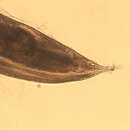en
names in breadcrumbs


Nematodes (roundworms) in the genus Oesophagostomum cause the parasitic disease in humans known as oesophagostomiasis. Oesophagostomum bifurcum is the main Oesophagostomum species of medical relevance to humans. Oesophagostomum nematodes belong to the nematode group known as bursate nematodes, which also includes the Ancylostoma hookworms, among others (males of bursate hookworm species have a copulatory bursa at the posterior end which wraps around the female during mating). Oesophagostomum species are widely distributed and occur wherever livestock is raised, but are more common in the tropics and subtropics. The highest incidence of infection in humans is in the northern regions of Togo and Ghana, where O. bifurcum appears to cycle naturally in human populations and can reach an extremely high prevalence of infection. Sporadic cases in humans have also been recorded in Brazil, Malaysia, Indonesia, French Guiana, and West Africa. Common livestock such as sheep, goats, and swine, as well as non-human primates, are the usual definitive hosts for Oesophagostomum species, but other animals, including humans and cattle, may also serve as definitive hosts.
Recent work has suggested that cross-infection between humans and non-human primates is limited or absent and that O. bifurcum from humans in the north of Ghana and O. bifurcum from olive baboons and/or mona monkeys are distinct, although further investigation of this issue is necessary (van Lieshout et al. 2005; Gasser et al. 2006 and references therein). Although asymptomatic infection is common, these parasites can cause serious pathological effects and intestinal disease in humans, as well as in non-human primates. Gasser et al. (2006) reviewed the biology, epidemiology, and population genetics of Oesophagostomum bifurcum. (Gasser et al. 2006 and references therein)
Oesophagostomum bifurcum is dioecious (i.e., there are separate males and females). Each female produces around 5000 eggs per day. Eggs are shed in the feces of the definitive host and may be indistinguishable from the eggs of Necator and Ancylostoma hookworms (co-infection with N. americanus is common). Eggs hatch into rhabditiform (L1) larvae in the environment, given appropriate temperature and level of humidity. In the environment, the larvae will undergo two molts and become infective filariform (L3) larvae. Worms can go from eggs to L3 larvae in a matter of a few days, given appropriate environmental conditions. Definitive hosts become infected after ingesting infective L3 larvae. After ingestion, L3 larvae burrow into the submucosa of the large or small intestine and induce cysts. Within these cysts, the larvae molt and become L4 larvae. These L4 larvae migrate back to the lumen of the large intestine, where they molt into adults. Eggs appear in the feces of the definitive host about a month after ingestion of infective L3 larvae.
(Centers for Disease Control Parasites and Health website; Gasser et al. 2006 and references therein)